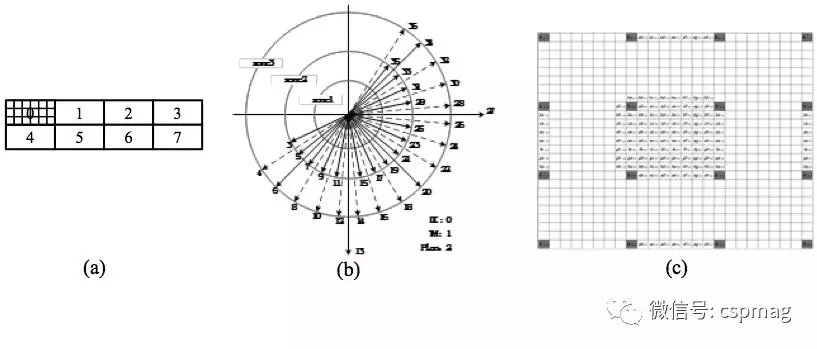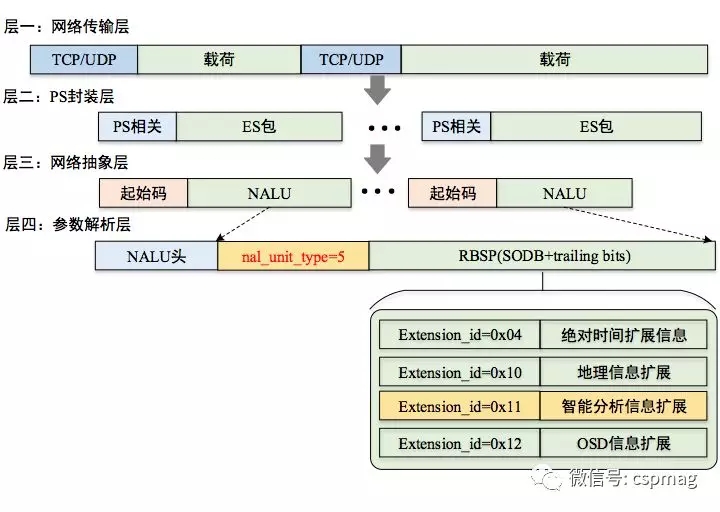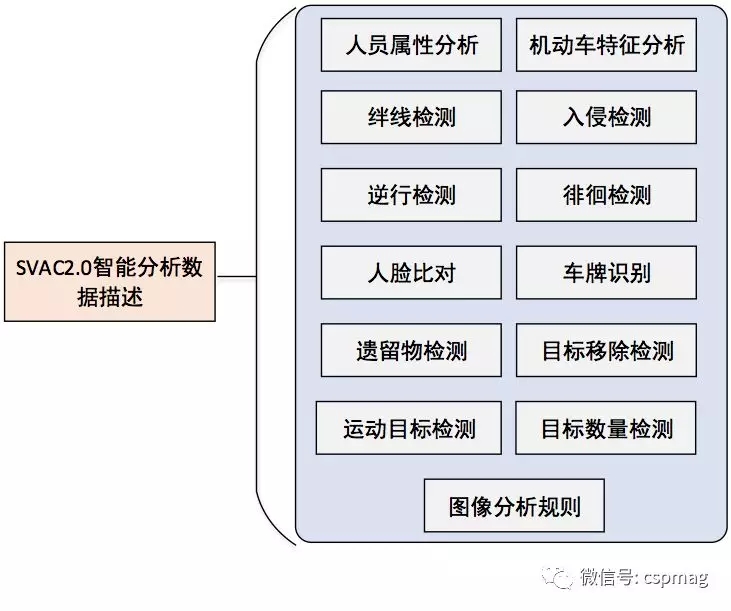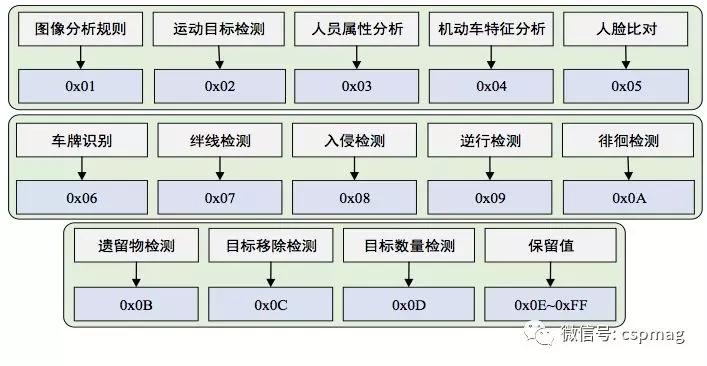SVAC 2.0 performs comprehensive improvement and support for the intelligent analysis of edge computing intelligence of embedded smart cameras, introduces real-time intelligent analysis result descriptions and other monitoring specific information, increases geographic location information, and stipulates the structure of common front-end real-time intelligent analysis information. The data format and the carrying method are transmitted and stored together with video and audio compression and encoded data through specialized grammar. The intelligent analysis data is standardized and managed. At the same time, there are more forms of reserved space for compatibility with more intelligent data. It is a large-scale monitoring network. Smart Management provides important technical support.
1. SVAC 2.0's efficient compression technology
The main technical features of the SVAC 2.0 standard include: support for high-precision video data encoding, support for various intra-frame and inter-prediction, transform quantization, binary arithmetic coding, and other technologies, support for ROI variable quality coding, scalable video Encoder (SVC) technology supports dual-core audio coding for Algebraic Code Excited Linear Prediction (ACELP) and Transform Audio Coding (TAC) switching, supports encoding of voice recognition feature parameters, and supports monitoring of dedicated information such as absolute time reference information and intelligent analysis information. , Support data security protection, support video data encryption and authentication.
Specifically, SVAC 2.0's image space segmentation no longer supports multiple bands, but supports the division of tiles, as shown in Figure 1(a). An image can be divided into several tile areas horizontally and vertically. These Tiles consist of a series of Coding Tree Units (CTUs). Based on this, SVAC 2.0 increases parallel computing support, and multiple Tiles simultaneously encode, speeding up the encoding speed. The basic operation unit size of SVAC2.0 has been upgraded from the previous 16X16 to 128X128, and can be further divided into a prediction unit (PU) and a transform unit (TU). The division manner is determined by a coding tree. The intra-prediction mode has been increased from 5 in SVAC 1.0 to 37, as shown in Figure 1(b), which refines the prediction direction and better adapts to the texture in different directions of the video content, making the prediction more accurate. At the same time, the precision of the motion search interpolation is improved to 1/8 pixel accuracy, as shown in Fig. 1(c) using an 8-tap filter for interpolation to optimize the interpolation results. SVAC 2.0 adds four sizes of discrete sine transforms (DST) and increases the original discrete cosine transform size to a maximum of 32X32, further improving the compression performance.

Figure 1 SVAC2.0 Improvement Technology
2.SVAC2.0 intelligent analysis data support
The development of the times and technology has enabled more and more new technologies to be applied in cameras. With the gradual promotion of deep learning, artificial intelligence, and high-performance computing, more and more intelligent algorithms are applied to front-end devices. In order to ensure the unified management of intelligent information, SVAC2.0 combines intelligent analysis technology, refines intelligent information, sorts and sorts intelligent information, and adds intelligent analysis-specific information to provide structured information for intelligent video processing under the premise of ensuring real-time video and audio encoding and decoding. stand by.
In supporting front-end embedded intelligent analysis data applications, as shown in Figure 2, SVAC2.0 mainly defines the standard format of smart data from aspects such as image analysis rules, target detection and feature analysis, target identification, behavior analysis, and target quantity statistics. , increase geographical position information, prescribe the data format and carrying method of commonly used front-end intelligent analysis information, and finally use a special grammar to analyze and generate related alarm information, etc., and transmit and store synchronously with the video stream, thus saving resources. Standardized management facilitates comprehensive application of fast retrieval, classification and query, video and audio synchronization and monitoring data.
Figure 2 SVAC2.0 intelligent analysis data description
3. SVAC2.0 edge computing intelligent data carrying method
SVAC2.0 specifies specific carrying methods for edge computing intelligence information and commonly used intelligent analysis results. In the monitoring and expansion data unit, the extended grammar of intelligent analysis information is added, and the way in which the result obtained by the intelligent analysis algorithm of the monitoring video coded into the video stream is defined. In this way, the intelligent analysis process between the center and the encoder is separated, and the video encoder carries the results of the smart analysis into the code stream and transmits it. The center only needs to read the results of the intelligent analysis after the edge calculation, and then perform a comprehensive comparison. Collisions greatly reduce the pressure on the central analysis data and provide technical support for monitoring video big data analysis applications.
In terms of stream structure, as shown in Figure 3, SVAC 2.0 uses a hierarchical structure similar to SVAC 1.0 to free most of the grammars belonging to the GOP layer and Tile layer and form a sequence parameter set SPS (Sequence). Parameter Set, Picture Parameter Set (PPS), Security Parameter Set (SePS), and Extension Parameter Set (EPS). Among them, the content of the sequence parameter set roughly includes decoding related information, such as grade level, resolution, coding tool switch identification in a certain grade, parameters involved, and time domain scalable information. The content of an image parameter set roughly includes a common parameter set used for one frame of the image, such as a quantization parameter, a Tile-related syntax element, a deblocking filter-related syntax element, and the like. The security parameter set includes the encryption and authentication switches required for decoding and the security parameter information such as the version number of the video key encryption key. The extended parameter set is mainly used to record monitoring-specific information such as absolute time information and OSD information.

Figure 3 SVAC2.0 code stream structure
From FIG. 3, it can be seen that after the network transmits and recombines the payload packets, the ES video stream can be obtained after PS decapsulation, and when parsing to a data unit of nal_unit_type=5, the decoder parses it into a monitoring dedicated data unit. SVAC2.0 refines the content of this unit, according to the different Extension_id can be divided into absolute time extension information (0x04), geographic information extension (0x10), intelligent analysis information extension (0x11) and OSD information extension (0x12) four kinds of monitoring Dedicated information.
Figure 4 Correspondence between intelligent analysis data analysis_id[i] and smart features
SVAC 2.0 fully considers the video features that are closely related to public safety. These features play an important role in the handling of public security cases, monitoring public opinion, and maintaining public order. They support image analysis rules, target detection and feature analysis, and target recognition. The main data of behavior analysis and target quantity statistics are defined in a normative format. Figure 4 shows the mapping relationship between these features and the syntax element analysis_id[i] (analysis function identifier of the i-th analysis result). 0, 1 or more intelligent analysis results can be carried in a video stream. The number can be represented by the syntax element analysis_num. The representation of each analysis result also defines the structured specification format. The description form of the i-th analysis result can be known by the value description_type[i]. When the value is 0x02, the manufacturer can customize the description form. When it is 0x03, it must comply with the provisions of the structural description in the national standard. At the same time, SVAC2.0 also has extremely strong compatibility and extensibility. The values ​​of 0x0E to 0xFF are reserved in the value of analysis_id, which is a good starting point for further detailed video features. The description_type values ​​0x00 and 0x03 are reserved, and the description format is compatible. More description of the structure. In the video stream, it is possible to clearly know the number of smart analysis results carried by the current video stream and which identification function is represented respectively.
Sweater
Sweaters are knitted by machine or by hand. The history of sweater knitting is very long. Human beings used leaves and animal skins to cover their bodies in primitive life, and later learned to use knitting techniques, so sweaters were produced. With the evolution of civilization and the invention of technology, there are more and more types of sweaters, with better and better quality. The function of sweaters is generally to keep warm, but with the progress of mankind, people began to pursue the beauty of sweaters.
Our company can produce various styles of sweaters. You are welcome to provide drawings and we will customize them for you.
Yacheng Knitting Co., Ltd. can mass produce customized high-quality knitted garments, including sweaters, Custom Knit Sweaters, Knitted Pants, Knitted Skirt, Knitted Shoes, Knitted Scarves and Knitting Blanket. If you need to order knitted products, please contact us.

Oem Sweater,Oem Mens Sweater,Popcorn Sweaters,Women Custom Sweater
DongGuan Yacheng Knitting Co., Ltd , https://www.oemknittingyc.com




